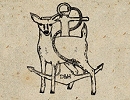Contact Seller
Doe And Hope
Tel07729 213013Please quote Antiques Atlas.


 Victorian Hearing Aids / Cornets in Leather Case
Victorian Hearing Aids / Cornets in Leather Case
 Pitch Pine Measuring Stick or Somastometre
Pitch Pine Measuring Stick or Somastometre
 Pharmacy Syringe in Beech Case by Wm Toogood Ltd
Pharmacy Syringe in Beech Case by Wm Toogood Ltd
 Dr Forbes Specifications Bath Thermometer
Dr Forbes Specifications Bath Thermometer
 Antique Wood & Brass Pill Roller from a Pharmacy
Antique Wood & Brass Pill Roller from a Pharmacy
 A Maw & Sons 19th Century Cast Iron Tincture Press
A Maw & Sons 19th Century Cast Iron Tincture Press
 Set of Apothecary Weights in Block / Stand,c1860
Set of Apothecary Weights in Block / Stand,c1860
 Dentist Treadle Mill. 19th Century.
Dentist Treadle Mill. 19th Century.
 WW11, Attaché Case First Aid Medical Equipment
WW11, Attaché Case First Aid Medical Equipment
 Vintage Medical Lab Allergy Test Solutions,1934
Vintage Medical Lab Allergy Test Solutions,1934
 Boxed Set 72 Histology Tissue Sample Slides,c1900
Boxed Set 72 Histology Tissue Sample Slides,c1900
 Antique Rustic Outdoor Medical Stretcher
Antique Rustic Outdoor Medical Stretcher
Non UK callers :
+44 7729 213013
Quartet of Graduating c1895 Apothecary Bottles


The graduating LUG (labels under glass) clear high quality flint glass chemist bottles having the original cut stoppers, and frosted necks, the Latin under the glass labels reading TINCT VALERIAN, FERRI ET QUIN CIT, ALUM UST and TINCT CATECHU all being shield shaped on white grounds with red, black and orange borders, and three marked to the bases “E.S & Co L Registered no 265897” surviving from the last quarter of the nineteenth century.
Structurally the pieces are sound with no cracks or chips aside from one crack to the neck of the Ferri Et Quin Cit bottle. The stoppers are sound and free. E. S. & Co could possibly be for Evans, Sell & Company, Pittsburgh, Pennsylvania (1873-1877).
These bottles were part of Wilfred Harris’ inventory at his dispensing chemist’s at 6 Albert Road, Bournemouth, UK, well into the early twentieth century. Earlier painted labels were eventually phased out and replaced with labels under glass (LUG) like these later in the century so as to stop the abrasion of the labels themselves.
The first would have bore tincture of valerian which excites the cerebro-spinal system. Large doses cause headache, mental excitement, visual illusions, giddiness, restlessness, agitation, and even spasmodic movements, and frequently nausea. In medicinal doses it acts as a stimulant-tonic, antispasmodic and calmative, and has been used in chorea, hysteria, and in the low forms of fever, where a nervous stimulant is required. Valerian is also one of many agents which have been used for the relief of epilepsy.
The second vessel would have held ferric quinine citrate. Quinine is a general protoplasmic poison, and in sufficient concentration paralyses all forms of living matter. Many persons show a marked idiosyncrasy to quinine, and comparatively small closes may produce symptoms of "quinism," including giddiness, headache, humming noises in the ears, with deafness that may last a few hours, disturbances of vision, and sometimes erythematous or urticarial skin eruptions. Quinine is employed in headache and neuralgia, hay fevers, and influenzal catarrhs, usually in the form of the sulphate, hydrochloride, or hydrobromide.
The third bottle contained potassium aluminum sulfate, with Ust meaning ustum which is Latin for “heated” and is actively astringent. It coagulates the albumin in the tissues and in the blood, produces local contraction of the capillaries, is somewhat escharotic, and produces induration of the skin and tissues. It at first excites and subsequently diminishes the salivary secretion and the secretions of the mucous surfaces of the mouth and stomach, diminishing the secretion of the gastric fluids, and precipitating pepsin.
The fourth would have held Tincture of Catechu, an extract of Acacia, useful in chronic diarrhoea, chronic dysentery, etc. It may be administered in some mucilage, sweetened water, or port wine.
A quartet of quality glassware that would instantly cheer up a boring shelf or a much-maligned mantelpiece.
SellerDoe And Hope
View all stock from
Doe And Hope

 Private dealer, By appointment only
Private dealer, By appointment only
The Onion Barn, Shoe Cottage,
15 High Street, Blunham,
Bedfordshire, MK44 3NL.
MK44 3NL
Tel : 07729 213013
Non UK callers : +44 7729 213013
Get directions to Doe And Hope
Structurally the pieces are sound with no cracks or chips aside from one crack to the neck of the Ferri Et Quin Cit bottle. The stoppers are sound and free. E. S. & Co could possibly be for Evans, Sell & Company, Pittsburgh, Pennsylvania (1873-1877).
These bottles were part of Wilfred Harris’ inventory at his dispensing chemist’s at 6 Albert Road, Bournemouth, UK, well into the early twentieth century. Earlier painted labels were eventually phased out and replaced with labels under glass (LUG) like these later in the century so as to stop the abrasion of the labels themselves.
The first would have bore tincture of valerian which excites the cerebro-spinal system. Large doses cause headache, mental excitement, visual illusions, giddiness, restlessness, agitation, and even spasmodic movements, and frequently nausea. In medicinal doses it acts as a stimulant-tonic, antispasmodic and calmative, and has been used in chorea, hysteria, and in the low forms of fever, where a nervous stimulant is required. Valerian is also one of many agents which have been used for the relief of epilepsy.
The second vessel would have held ferric quinine citrate. Quinine is a general protoplasmic poison, and in sufficient concentration paralyses all forms of living matter. Many persons show a marked idiosyncrasy to quinine, and comparatively small closes may produce symptoms of "quinism," including giddiness, headache, humming noises in the ears, with deafness that may last a few hours, disturbances of vision, and sometimes erythematous or urticarial skin eruptions. Quinine is employed in headache and neuralgia, hay fevers, and influenzal catarrhs, usually in the form of the sulphate, hydrochloride, or hydrobromide.
The third bottle contained potassium aluminum sulfate, with Ust meaning ustum which is Latin for “heated” and is actively astringent. It coagulates the albumin in the tissues and in the blood, produces local contraction of the capillaries, is somewhat escharotic, and produces induration of the skin and tissues. It at first excites and subsequently diminishes the salivary secretion and the secretions of the mucous surfaces of the mouth and stomach, diminishing the secretion of the gastric fluids, and precipitating pepsin.
The fourth would have held Tincture of Catechu, an extract of Acacia, useful in chronic diarrhoea, chronic dysentery, etc. It may be administered in some mucilage, sweetened water, or port wine.
A quartet of quality glassware that would instantly cheer up a boring shelf or a much-maligned mantelpiece.
Price The price has been listed in British Pounds.
Conversion rates as of 9/JUL/2025. Euro & Dollar prices will vary and should only be used as a guide.
Always confirm final price with dealer. Phone or visit the website to buy, Free UK shipping.
DimensionsRanging From
Base Diameter 2.25 inches
Height 6.75 inches
To
Base Diameter 3 inches
Height 8 inches
Category Medical Antiques
Date c.1895
Late Victorian Antiques Material Glass
Origin English
Condition Good.
Item code as155a873
Status Sold
£155.00 
$210.61 
€179.78 

$

€

Conversion rates as of 9/JUL/2025. Euro & Dollar prices will vary and should only be used as a guide.
Always confirm final price with dealer. Phone or visit the website to buy, Free UK shipping.
View all stock from
Doe And Hope

 Private dealer, By appointment only
Private dealer, By appointment onlyThe Onion Barn, Shoe Cottage,
15 High Street, Blunham,
Bedfordshire, MK44 3NL.
MK44 3NL
Tel : 07729 213013
Non UK callers : +44 7729 213013
Get directions to Doe And Hope
You may also be interested in
 Victorian Hearing Aids / Cornets in Leather Case
Victorian Hearing Aids / Cornets in Leather Case
 Pitch Pine Measuring Stick or Somastometre
Pitch Pine Measuring Stick or Somastometre
 Pharmacy Syringe in Beech Case by Wm Toogood Ltd
Pharmacy Syringe in Beech Case by Wm Toogood Ltd
 Dr Forbes Specifications Bath Thermometer
Dr Forbes Specifications Bath Thermometer
 Antique Wood & Brass Pill Roller from a Pharmacy
Antique Wood & Brass Pill Roller from a Pharmacy
 A Maw & Sons 19th Century Cast Iron Tincture Press
A Maw & Sons 19th Century Cast Iron Tincture Press
 Set of Apothecary Weights in Block / Stand,c1860
Set of Apothecary Weights in Block / Stand,c1860
 Dentist Treadle Mill. 19th Century.
Dentist Treadle Mill. 19th Century.
 WW11, Attaché Case First Aid Medical Equipment
WW11, Attaché Case First Aid Medical Equipment
 Vintage Medical Lab Allergy Test Solutions,1934
Vintage Medical Lab Allergy Test Solutions,1934
 Boxed Set 72 Histology Tissue Sample Slides,c1900
Boxed Set 72 Histology Tissue Sample Slides,c1900
 Antique Rustic Outdoor Medical Stretcher
Antique Rustic Outdoor Medical Stretcher




